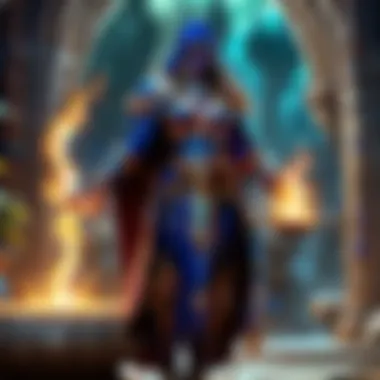Discovering Influential Sorcerers Throughout History


Intro
The intrigue surrounding sorcery stretches back through the annals of time, reverberating across diverse cultures and civilizations. In this exploration, we’re diving into the rich tapestry of sorcerers—those masterful practitioners of the arcane arts whose footsteps echo through history. From enchanting healers to cunning illusionists, the legacies of these spellcasters continue to captivate our imaginations.
Every civilization, whether ancient or modern, has woven its unique brand of magic into the societal fabric. The practices and beliefs associated with sorcery resonate with the cultural contexts from which they emerged. This article seeks not just to scratch the surface, but to delve deeper into the identities of these remarkable figures, understanding their significance, methodologies, and the nuanced legacies they left behind.
By examining various traditions of sorcery, we hope to provide a comprehensive understanding of how these practitioners have shaped societies, influenced art and culture, and altered the course of history in ways that may still touch our lives today. Join us, as we embark on this journey to appreciate the mysterious and often misunderstood world of sorcery.
Preamble to Sorcery
Sorcery has captivated the human imagination for centuries. It’s a topic that transcends cultures and eras, echoing the mysteries of our relationship with the unknown and the supernatural. This section lays the groundwork for understanding sorcery not just as a mystical practice, but as a reflection of societal norms, beliefs, and the innate desire for control over fate. Delving into this subject opens avenues for appreciating the craft's significance in various historical contexts, revealing how sorcery intertwines with identity and culture.
Defining Sorcery
Sorcery can be seen as a delicate dance between the practitioner and the forces they seek to manipulate. While it’s often viewed through a fantastical lens, sorcery has deep roots in reality. In many cultures, it’s considered a method of channeling energy to achieve specific outcomes—be it healing, protection, or even revenge. The term is sometimes used interchangeably with "magic"; however, they diverge in nuances. Sorcery generally implies a more tactical approach, often involving rituals, spells, and specific tools, while magic can encompass a broader spectrum of mystical practices.
Understanding this distinction is crucial as it sets the stage for the complexities inherent in sorcery. It's like trying to decipher the weather; one can observe the clouds and predict rain, yet only the meteorologist understands the intricate systems in play.
Historical Context
The historical narrative of sorcery is as varied as the cultures that practice it. From ancient Egypt's intricate rites, designed to summon deities and secure favor in the afterlife, to the witch hunts of medieval Europe, sorcery has left an indelible mark on human history. Even today, it colors modern spiritual practices, often echoing ancient philosophies.
For instance, in Mesopotamian cultures, enacting spells was a common way to protect crops and homes from spirits, showcasing an early form of animism and reverence for nature. Quite different yet equally representative are the indigenous traditions found in various parts of the globe, where shamans often acted as mediators between the spiritual and physical worlds.
Historical instances of sorcery shine a light on the often blurred lines between spirituality and survival. Such practices were not merely entertainment; they were essential to the community fabric.
By gaining an appreciation for these varied practices, we understand how sorcery has been less about dark arts and more about human connection—whether to one another, to nature, or to the cosmos. This context serves as a powerful reminder of sorcery's role in shaping societal narratives and ensuring continuity across generations.
Cultural Perspectives on Sorcery
The exploration of sorcery across various cultures provides a rich tapestry that highlights the societal norms, spiritual beliefs, and historical contexts in which these practices were rooted. Understanding cultural perspectives on sorcery allows readers to appreciate not only the craft itself but also how it influenced and shaped civilization globally. Each culture has its own interpretations, tools, and rituals that have evolved over time, reflecting their unique worldviews and values. By delving into these cultural perspectives, we can uncover significant insights into the human experience and the historical footprints left by these magical traditions.
Sorcery in Ancient Civilizations
Egyptian Sorcery
Egyptian sorcery is a fascinating blend of their religious beliefs and an understanding of the natural world. The ancient Egyptians viewed magic as a vital component of everyday life; it was woven into their rituals, daily activities, and even their governance. One of the most significant aspects of Egyptian sorcery was their use of spells and incantations, often recorded on papyrus or carved into tombs.
These spells were not merely fanciful words; they were believed to have real power, intended to invoke the gods or protect the deceased in the afterlife. The key characteristic of Egyptian sorcery is its profound connection to the divine, which made it a beneficial practice in securing favor from the gods.
The unique feature of Egyptian sorcery lies in its focus on the afterlife and the souls of the departed. This focus ensured that many rituals were geared toward securing a safe passage and favorable conditions for the dead. However, while its influence is significant, the practice also faced scrutiny from early monotheistic belief systems, becoming less popular over time.
Mesopotamian Practices
In contrast, Mesopotamian practices were largely practical and community-oriented. Sorcery in this ancient region was often intertwined with medicine and crop fertility, aiming to address everyday concerns. Priests, known as asipu, utilized charms and incantations to heal the sick or to ward off illness from livestock and crops—demonstrating how sorcery was integrated into the fabric of societal wellbeing.
The key characteristic here is the dual nature of sorcery: as a means of protection and a healing art. This intertwining of magic with medicine showcases the pragmatic approach of Mesopotamian cultures toward their challenges. A unique feature of their sorcery involves the extensive use of written tablets, where numerous incantations and rituals were preserved, allowing for the continued application of these practices across generations. However, their ambiguous moral implications, especially concerning power and control, may have led to differing levels of acceptance over time.
Indigenous Traditions
Indigenous traditions present another layer of complexity to the understanding of sorcery. Through oral traditions, many indigenous cultures have preserved their magical practices, often centered on a deep reverence for nature. The key characteristic of indigenous sorcery is its community-oriented aspect, with rituals often conducted in groups to honor spirits, ancestors, and the environment.
What sets these traditions apart is the concept of harmony with nature. Many rituals focus on maintaining balance, recognizing that all forms of life are interconnected. This unique feature provides a spiritual framework that fosters environmental stewardship. The main challenge, however, lies in the erosion of these traditions due to colonization and modernization, which has led to a loss of ancient knowledge.
Modern Interpretations
Neo-Paganism
As we shift to modern interpretations of sorcery, Neo-Paganism stands out as a revival of ancient practices intertwined with contemporary beliefs. This modern movement draws on ancient traditions, yet adapts them to fit within current contexts. One critical aspect of Neo-Paganism is its embrace of nature worship and the cycle of the seasons, echoing the earlier indigenous beliefs yet framed within a modern spiritual context.


The key characteristic of Neo-Pagan practices is their inclusivity; they invite diverse spiritual expressions and often promote a sense of community among practitioners. This has made it a popular choice for those seeking spiritual fulfillment in the modern age. However, while it offers many advantages, critics suggest that the revival risks cherry-picking elements without an understanding of their deeper cultural meanings.
Pop Culture Representations
Finally, pop culture representations have drastically altered how sorcery is perceived today. Movies, television shows, and literature often depict sorcery in a sensational light, disconnected from its historical roots. This medium has brought sorcery into mainstream consciousness, making it accessible and familiar, but at a cost. The allure of magic in pop culture can overshadow the complexities and genuine cultural significance of traditional practices.
A key feature of populist representations is their dramatic flair, which often leads to a simplified understanding of sorcery. While this has sparked interest in magical practices, it also carries the risk of trivializing serious traditions. The advantages of pop culture are undeniable in terms of visibility and engagement, yet the danger lies in the potential for misrepresentation and commodification of rich cultural histories.
"Sorcery, at its core, is not just about casting spells; it reflects the diverse tapestry of human civilization and its myriad beliefs."
In summary, examining cultural perspectives on sorcery allows us to frame the conversation around magic in ways that are meaningful and respectful of its origins. Whether through ancient Egyptian spells, Mesopotamian healing practices, indigenous harmony with nature, modern interpretations like Neo-Paganism, or the vivid narratives of pop culture, sorcery represents a fascinating intersection of mythology, culture, and spirituality.
Notable Sorcerers Throughout History
A deep dive into the lives of sorcerers throughout history reveals not just their magical practices but also their significant impact on culture, belief systems, and even societal structures. When we look at these notable figures, we don't just see practitioners of the arcane arts; we see individuals who challenged the boundaries of their times, either through their philosophies or their controversial practices. They illuminate the complexities of sorcery as both a craft and a cultural phenomenon, making their study vital to understanding the art of magic itself.
Famous Historical Figures
Aleister Crowley
Aleister Crowley, often referred to as the "Great Beast 666," has gained notoriety as one of the most significant figures in modern occultism. His contributions to Thelemic philosophy provided a mental framework for understanding the interplay of will and magic. By promoting the concept of "Do what thou wilt shall be the whole of the Law," Crowley offered a new lens to view personal freedom within the confines of moral responsibility. His unique characteristic lay in his unabashed pursuit of personal empowerment through various mystical practices.
While Crowley’s work, such as The Book of Shadows, has made him a cult figure in the realm of modern sorcery, it also comes with the baggage of controversy. Some laud his innovative approaches, while others dismiss him as a charlatan. His life's chaotic backdrop, filled with drugs, sex, and mysticism, can be both a disadvantage and an intriguing aspect of his legacy. In this article, he serves as a pivotal figure, illustrating the clash of ideals that can emerge in the exploration of sorcery.
Paracelsus
Paracelsus, a name echoing through the halls of alchemy and medicine, was a seminal figure in bridging these two worlds. His motto, "The dose makes the poison," showcases his groundbreaking approach to medicine and how it intertwined with magical practices of the time. Unlike previous practitioners, Paracelsus emphasized observation and experience over textbook knowledge. He believed in the vital force within all things, blending aspects of magic with natural philosophy, which further evolved our understanding of healing.
A key characteristic of Paracelsus was his rejection of traditional medical norms, which paved the way for more holistic and empirical practices. This openness to new ideas can be beneficial in understanding how sorcery has transformed into various practices today. However, this same approach may alienate purists who advocate for preserving ancient methods. Despite that, his legacy remains crucial for those interested in how sorcery has shaped medical practices and spiritual healing.
Merlin
Merlin, the legendary wizard of Arthurian lore, personifies the fusion of magic and mythology. Often depicted as a wise and powerful mentor to King Arthur, his character embodies the archetype of the sage, which can significantly influence the perception of sorcery in popular culture. Merlin's mythical nature allows for an exploration of the symbols and narratives surrounding sorcery, offering insights into how magical figures have shaped collective imaginations.
Merlin’s significance is further illustrated through various adaptations in literature and film, where he serves as a bridge between ancient wisdom and modern storytelling. His unique blend of prophecy, wisdom, and magic highlights the aspirational aspect of sorcery—a desire to understand hidden truths and navigate life's complexities. While some may argue that his mythical roots detract from a realistic study of sorcery, his enduring presence in cultural narratives makes him a compelling figure in any discourse on historical sorcerers.
Influential Modern Practitioners
Gerald Gardner
Gerald Gardner is often credited with founding modern Wicca, a movement that has made waves across various spiritual landscapes. His life and writings—particularly Witchcraft Today—have laid the foundations for a revival of interest in ancient pagan practices. Gardner's open embrace of sexual freedom, nature worship, and rituals made Wicca more accessible to the general public, thus expanding its appeal.
The key characteristic of Gardner's work is his ability to bridge the gap between traditional witchcraft and contemporary paganism. He is viewed as a beacon of modern witchcraft and remains a pivotal reference point for those exploring Wiccan practices today. This duality—balancing historical authenticity with modern practices—offers a rich field for study. However, critics might argue that some of Gardner's materials lack rigor and accuracy, which can complicate the landscape of modern witchcraft.
Raymond Buckland
Raymond Buckland, known for popularizing Wicca in the United States, played a vital role in making the practice widely recognized and respected. His book, The Witch Book: The Encyclopedia of Witchcraft, Wicca, and Neo-Paganism, functions as a comprehensive resource for budding practitioners. Buckland’s contributions to the field go beyond mere literary contributions; he actively promoted education and understanding of the craft in a way that few had managed before him.
The distinctive feature of Buckland's work was his focus on inclusivity, aiming to demystify witchcraft and offer practical guidance for practitioners of all levels. This accessibility can be seen as one of his greatest strengths. Still, the issue of oversimplifying complex traditions often emerges. Regardless, Buckland stands as a notable figure in the evolution of sorcery, emphasizing the importance of balance between esoteric knowledge and approachable practices.
Exploring these remarkable sorcerers not only enriches our understanding of magic but also illuminates how their legacies inform and inspire contemporary practices across cultures.
The Craft of Sorcery
The craft of sorcery is a multifaceted discipline steeped in history and tradition, reflecting the intricate tapestry of human belief and creativity. It serves as the backbone of this exploration into renowned sorcerers, revealing how individuals interact with and manipulate their environments through unique practices. Sorcery is not simply about casting spells; it's a mean of connecting with the world, employing tools and rituals that bridge the material and the mystical. This section aims to provide insights into the elements of sorcery, discussing tools and ingredients, rituals and spells, as well as various schools of thought that contribute to understanding this ancient craft.
Basic Elements of Sorcery


Tools and Ingredients
When it comes to sorcery, tools and ingredients are crucial components that form the practical framework upon which many practices are built. These can include anything from wands and chalices to herbs and crystals. Such items aren’t just mundane objects—they are often imbued with symbolic significance that resonates with the practitioner’s intent. For instance, garlic is frequently used for protection, embodying a characteristic connection to health and vitality.
The beauty of incorporating specific tools lies in their diverse applications. Each item brings its own unique energy and purpose, allowing practitioners to tailor their practices. Tools not only serve as a focus for magical energy but can also enhance the efficacy of spells. When aligned with the practitioner’s intent, ingredients can add potency to rituals, making them invaluable resources. However, it’s worth noting that over-reliance on external tools can lead to a disconnect from one's innate abilities, a pitfall for aspiring sorcerers.
Rituals and Spells
Rituals and spells, central to the practice of sorcery, function as the articulations of intent and energy manipulation. These are often performed in a structured manner, facilitating the connection between the practitioner and the desired outcome. The key characteristic of rituals is their repetitive nature, which helps build momentum and focus. For example, lighting candles or chanting specific phrases can create a tangible atmosphere steeped in intention, heightening the magical experience.
The uniqueness of spells lies in their variability. From binding spells to healing rituals, the scope is wide and tailored to the practitioner’s needs. They serve as powerful tools for manifestation. However, it’s essential to tread carefully, as the energy worked with can have unforeseen impacts. The ethical implications of spellcasting must always be considered, reminding sorcerers that intention is paramount.
Schools of Thought
Natural Magic
Natural magic is a practice deeply connected to the rhythms of nature. Emphasizing harmony with the environment, it draws on elements such as moon phases, seasons, and even weather patterns to inform its rituals. The inherent benefit of this approach is its accessibility— practitioners often use readily available natural elements, be it stones, plants, or even the earth.
One of the unique features of natural magic is its adaptive quality. It encourages practitioners to be observant of their surroundings, fostering a profound connection to the world. Natural magic is popular among those who appreciate the simplicity and directness of working with nature. However, it can also be criticized for its lack of structured frameworks, which some may find unappealing when seeking more defined methodologies.
High Magic vs. Low Magic
The distinction between high magic and low magic illustrates a spectrum of practices within the realm of sorcery. High magic is often viewed as more ceremonial, elaborate in its approaches and frequently linked to spiritual ascension or profound transformation. It usually involves complex rituals, extensive preparations, and a significant amount of study. This is appealing for many as it promises deep spiritual reward and insight. On the other hand, low magic tends to focus on practical daily applications—such as charms, healing, and protection.
Each type has its unique characteristics. High magic shines through its intricate ceremonial practices which can feel awe-inspiring. Conversely, low magic is appreciated for its immediacy and often, its effectiveness in dealing with everyday issues. However, both have their critiques; high magic can sometimes be seen as overly pompous or inaccessible, while low magic might be dismissed as trivial or lacking depth.
"The tools and rituals of sorcery act as bridges, inviting us to explore the mysterious interplay of intention and reality."
Understanding these facets—the craftsmanship of tools, the significance of rituals, and the varied schools of thought—offers invaluable insight into the rich and diverse world of sorcery. For those engaged in the craft, it paves way for deeper connection to their practice and a greater appreciation of the legacy left by practitioners across centuries.
The Ethics of Sorcery
The realm of sorcery, with its rich tapestry of lore, rituals, and practices, brings to light a critical area often overlooked—the ethics that govern the actions of sorcerers. Understanding the ethical considerations that come with wielding magical power is paramount for anyone delving into this intriguing world. The practices of sorcery are not just about casting spells or gathering ingredients; they are deeply entwined with personal responsibility and cultural meanings. In this section, we will explore two important aspects: moral considerations and cultural sensitivities surrounding sorcery.
Moral Considerations
At the heart of sorcery lies a profound moral dilemma. The power that practitioners wield can be as beneficial as it is destructive. When sorcerers engage in their craft, they often face choices that can affect not only themselves but also those around them. For instance, a sorcerer casting a protection spell may have the intent of keeping loved ones safe. However, what happens if those intentions lead to unintended consequences? This is where moral restraint becomes essential.
One key principle in the ethics of sorcery is the concept of intention—"the road to perdition is paved with good intentions" rings true in this context. Practitioners are encouraged to reflect deeply on their motivations behind any spell or ritual. Understanding whether their actions serve a greater good or simply personal desires can clarify their ethical stance.
Consider these moral questions when practicing sorcery:
- Who is affected by my actions? Are the intended benefits overshadowing potential harms?
- Am I respecting the free will of others? Magic is a force that can influence, but should it?
- What is the source of my magical practices? Ensuring that one’s methods are not exploiting cultural traditions can safeguard against ethical breaches.
Empathy and awareness go a long way in shaping a responsible sorcerer. Engaging in community discussions or consulting with fellow practitioners may provide guidance, fostering a culture of accountability.
Cultural Sensitivities
As sorcery traverses a wide variety of cultures, it becomes crucial to approach different traditions with sensitivity. Each culture brings its own myths, practices, and historical context to the practice of sorcery. Ignoring this rich diversity can lead to cultural appropriation or disrespect, which, in turn, diminishes the authenticity of magical practices.
It is imperative for sorcerers today to educate themselves on the cultural backgrounds surrounding their practices. Below are some guidelines for navigating these cultural lands wisely:
- Research Before Practicing: Understand the history and significance of rituals or symbols before incorporating them into your practice.
- Honor Source Cultures: Give credit to the origins of the traditions you draw from. This means respecting the beliefs and practices of the communities that hold them dear.
- Engage with Communities: Connect with practitioners from the cultures you wish to explore. Such dialogues can lead to a more profound understanding and mutual respect.
By acknowledging and honoring these cultural nuances, sorcery can evolve into a practice that celebrates diversity rather than appropriating it. In this way, sorcerers not only uphold ethical standards but also ensure that their work contributes positively to the broader tapestry of human experience.
"Magic has always been inextricably tied to the cultures from which it springs; thus, understanding these traditions is not just respectful but essential for meaningful practice."


In sum, the ethics of sorcery hinges on a combination of moral integrity and cultural awareness. As more people engage in the world of magic, the need for a thoughtful approach becomes increasingly important. Whether one is casting spells like a seasoned World of Warcraft player or dabbling in new practices, maintaining an ethical framework can ensure the art of sorcery remains a sacred and respected craft.
The Legacy of Sorcery
The legacy of sorcery is a captivating tapestry woven through the ages, reflecting the cultural, spiritual, and artistic significance that this ancient craft holds. Sorcery, often thought of as mere fantasy in modern perception, is deeply rooted in various historical contexts and has impacted society in numerous ways. Its influence extends beyond the mystical arts, intertwining with literature, art, and ethical considerations. Exploring the legacy of sorcery not only sheds light on its historical relevance but also allows us to appreciate how it shapes contemporary beliefs and practices.
Impact on Society
Influence on Literature and Art
Sorcery has left an indelible mark on literature and art, illustrating the eternal fascination with magical practices and the supernatural. This influence manifests in the works of authors like J.K. Rowling and Shakespeare, who drew on sorcery's themes to craft compelling narratives. The key characteristic of this influence is its ability to inspire creativity and evoke emotions, allowing readers and viewers to escape reality and delve into realms where anything is possible. This is a beneficial approach as it engages audiences while fostering a deeper understanding of human experiences and desires.
A unique feature of sorcery’s impact on literature and art is its duality; it can evoke wonderment and fear simultaneously. This makes storytelling more dynamic, captivating the audience’s senses. Yet, one has to be cautious; sometimes, the glorification of sorcery can lead to misunderstanding or misrepresentations of cultural practices. This means that while sorcery's artistic representation enriches society, it also carries responsibility to portray its origins and meanings respectably.
Legal Perspective through History
Throughout history, the legal outlook on sorcery has fluctuated wildly depending on cultural context and societal norms. In times of fear and superstition, individuals accused of practicing sorcery faced dire consequences; think of the notorious witch hunts in Europe and America. The key characteristic here lies in how legal systems exhibited zero tolerance towards what they deemed as threats to societal order. This perspective is crucial here because it shows how legal frameworks can shape social norms.
A unique aspect of the legal history surrounding sorcery is its capability to reflect broader societal fears, leading to witch hunts and unjust persecution. While legal repercussions aimed to maintain societal control, these actions led to profound cultural consequences and a legacy of distrust. As such, understanding the legal perspectives on sorcery helps illuminate the intersections between fear, power, and social engineering throughout history.
Contemporary Relevance
Spiritual Practices Today
Today, sorcery survives in various forms, from Wicca to modern witchcraft, each adapting ancient traditions to contemporary frameworks. The key characteristic of spiritual practices today is their focus on personal empowerment and self-discovery. This makes it a beneficial choice for a burgeoning community of seekers looking for meaning in a chaotic world.
A unique feature of these modern spiritual practices is their openness and inclusivity, allowing individuals to find their pathways without strict dogmas. This accessibility fosters a sense of belonging among practitioners, but it can also dilute the rich histories of original practices, which are vital to preserve.
Emerging Trends and Movements
As society evolves, so do the interpretations and practices associated with sorcery. Emerging trends often reflect a blend of traditional sorcery with modern spirituality, connecting ancient wisdom to current experiences. The key characteristic of these trends is their adaptability; they resonate with a generation that seeks authenticity in its spiritual journey. This becomes a popular choice for individuals looking for holistic lifestyles.
The unique feature of these movements is their reliance on digital platforms for community building and resource sharing. While this enhances global connectivity, it can lead to a superficial understanding of the practices. Thus, while the digital age breathes new life into sorcery, it also poses challenges regarding depth and authenticity.
"In examining the legacy of sorcery, we uncover layers of meaning that continue to influence society, art, and personal belief systems."
Epilogue: The Evolution of Sorcery
The exploration into the world of sorcery presents an intricate tapestry of beliefs, practices, and figures that span centuries. Understanding the evolution of sorcery is crucial for grasping not only its historical significance but also its impact in contemporary spirituality and cultural frameworks.
Sorcery is often fiercely debated; it oscillates between being seen as a mystical art form or a mere folk practice rooted in cultural heritage. This duality highlights a crucial element of the topic—the way sorcery adapts and mirrors societal changes.
In any examination of sorcery today, one must consider specific benefits drawn from its practices. Many find solace and empowerment in rituals that connect them to ancestral customs. Sorcery embodies an exploration of the self, forging a path toward understanding the unknown and tapping into personal power.
Ties to Modern Spirituality
In the modern landscape, spirituality often intertwines with the remnants of sorcery. Today’s spiritual seekers often engage with principles derived from ancient practices, recontextualizing them within contemporary frameworks. This transformation allows sorcery to resonate with modern values, such as individual empowerment and psychological growth.
Modern practitioners frequently embrace Neo-Pagan beliefs, which can be traced back to elements seen in traditional sorcery. Wiccans, for example, often perform rituals steeped in nature worship and spells driven by intent. The craft has managed to carve a niche within a broader spiritual context—where self-exploration is integral to the practice.
Moreover, social media platforms, like Facebook and reddit.com, have provided spaces for discussions and exchange of ideas, furthering the reach and accessibility of sorcery practices in society today.
Future of Sorcery
Looking ahead, the future of sorcery seems vibrant, informed by both tradition and innovation. As technological advancements reshape societal interaction, the practice of sorcery is likely to evolve as well. Emerging trends such as digital rituals, online workshops, and virtual community gatherings are already becoming commonplace.
Furthermore, an increasing interest in mental health and wellness directly influences how sorcery is perceived. Many turn to these ancient practices as a means of coping with modern stressors—be it through meditation, tarot readings, or spellcasting.
The dialogue around sorcery’s future also encompasses notions of cultural appropriation and the necessity of ethical practice. As sorcery is revived and reshaped, practitioners must consider the moral implications of their work. Engaging with these discussions will be vital to navigate the complexity of sorcery in a globally connected world.
"The magic is not in the spells but in the intent behind them."
In wrapping up this journey into sorcery, it’s evident that the practice continues to be a reflection of human curiosity and spirituality. Whether it serves as an artistic expression or a method of personal empowerment, the world of sorcery offers a fascinating glimpse into how we engage with the mysteries of existence.







